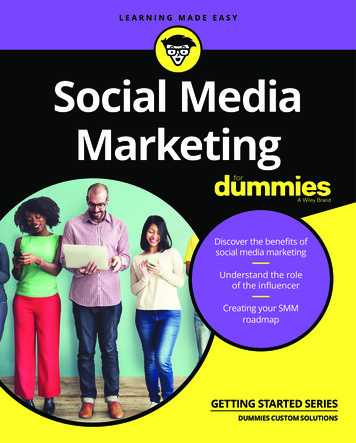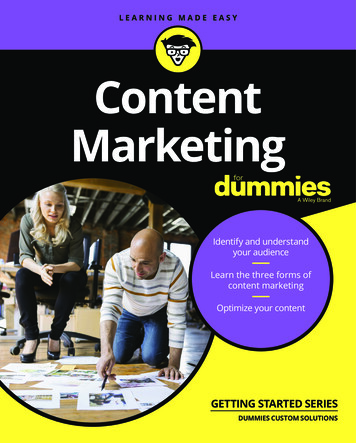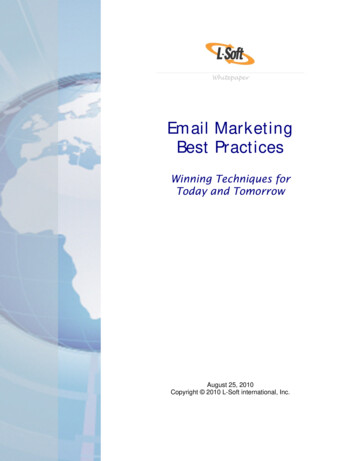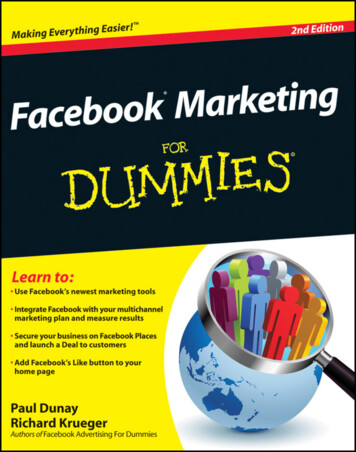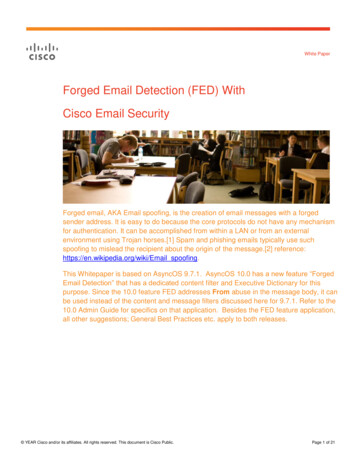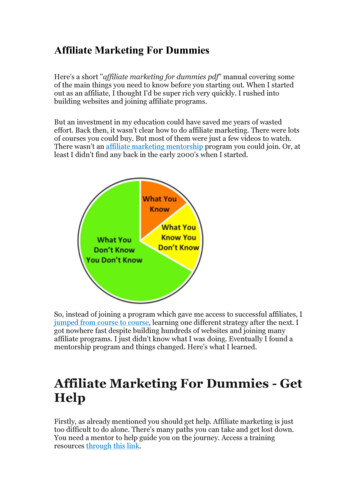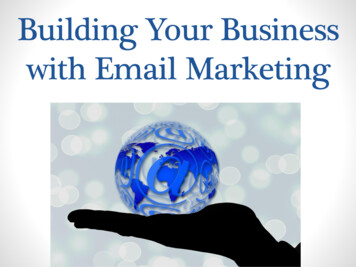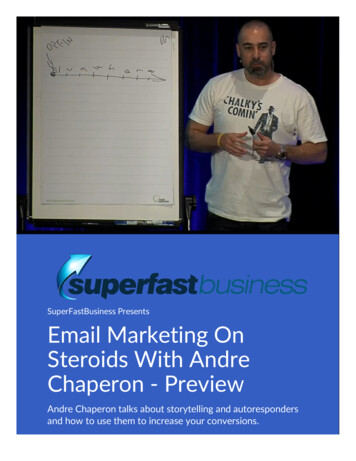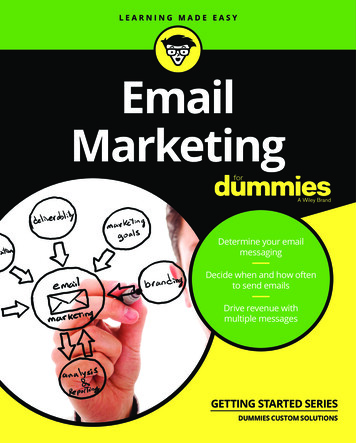
Transcription
EmailMarketingDetermine your emailmessagingDecide when and how oftento send emailsDrive revenue withmultiple messagesGETTING STARTED SERIESDUMMIES CUSTOM SOLUTIONS
IN THIS CHAPTER»» Determining what your emailmessages should say»» Deciding when and how often tosend»» Sending multiple messages todrive revenue»» Branding your messaging acrossall mediaAdding Email to YourMarketing MixReaching out to customers can seem like a daunting task, especially when youwant to reach several of them at once, but email marketing can make it easy. Asone of the fastest and most efficient ways of talking with your audience, emailmarketing allows you to connect with several customers at once and customize theexperience based on their level of engagement.Read on to discover how to use email as a key part of your overall marketingstrategy.Determining What Your EmailMessages Should SayEmail is a great marketing tool, but you can’t simply communicate any email message multiple times and expect the messages to result in sales. Make your emailmessages as concise as possible; people usually scan emails rather than take the
time to read every word. Clear and concise messages are by far the best choicefor email content, but your messages should include the following content at aminimum:»» Your value proposition: A value proposition is a statement that tells consum-ers why your products or services are worth paying for. A good value proposition shows consumers that your products or services solve a problem or fulfilla want or need better than anyone else can. Here are some examples of valuepropositions: “Don’t put Rover in a cage for the holidays. Our pet-sitting servicesmake your vacations worry-free and allow your pets to enjoy the holidaystoo — in the comfort of their own home.” “Want it tomorrow? Our free shipping is the fastest available.”“Our home equity loans can help you pay off high interest debt, and ourservice is more personal than the big banks.”»» Information to support your value proposition: Value propositions rarelyentice someone to make an immediate purchase all by themselves. Most ofthe time you need to support your value proposition with additional information to convince buyers to take action. You can include this supportive information along with your value proposition in one email message, or you mightneed multiple support messages delivered over periods of time. Examplesinclude: Content assets that help support your messagingTestimonials and factsDirections to your office, store, or websiteIncentives to help someone justify taking actionImages and other design elements to reinforce the text»» One or more calls to action: A call to action is a statement that asks someoneto take a specific type of action in a specific way. Calling for action is important because people tend to delete emails after they read them if they aren’ttold what to do next. For example, just because your phone number appearsat the bottom of an email doesn’t mean that people will automatically pickup the phone and dial the number. You’ll get better results if you ask youraudience to phone you for a specific reason; of course, provide the phonenumber. However, an effective call to action doesn’t necessarily entail askingAdding Email to Your Marketing Mix3
for an immediate purchase decision. Sometimes your prospective customershave to take many steps to end up with a store receipt in hand. Examples ofcalls to action could include: “Call now and ask for a free consultation.”“Click this link to add this item to your shopping cart.”“Click this link to download the informational video.”“Save this message to your inbox today.”“Print this ecard and bring it with you for a free cup of coffee.”Determining the most effective wording for your emails usually entails some testing combined with educated assumptions based on how your customer perceivesyour business and your products or services.Here are some questions to ask yourself to help determine what your email messages should say. As you answer each question, think in terms of what your customers find beneficial about your business instead of simply stating your owninterests:»» What are the features of your products or services?»» How will the features of what you sell benefit your consumers?»» How are you different from your competition?»» Why are your differences worth paying for?Summarize your answers to the previous four questions in a paragraph. Try to usetwo lines of text or ten words or fewer. You’re well on your way to crafting an emailmessage.If you aren’t sure how your customers would answer these questions, rewrite thequestions and ask a few of your customers to respond. You might be surprised bytheir answers!Targeting your email messagesWhen you’re excited about your business, thinking of almost everyone as a potential prospect is easy. You might indeed identify a large audience that needs yourproducts or services, but plenty of people won’t buy from you for one reason oranother.Adding Email to Your Marketing Mix4
At the same time, pockets of opportunity for communicating your messages mightexist that you haven’t thought of. You can make your email messages more effective by targeting prospects and customers who are most likely to make a purchasedecision and excluding people who are probably never going to buy. Here are somequestions you can ask yourself to help determine to whom you should send youremail messages:»» Who is most likely to need your products or services?»» Who already buys other products or services that are similar or identical toyours? For example, if your company makes roller skates, you may want tofind out everything you can about the people who buy roller skates and rollerblades from your competitors.»» Who buys other products or services that could be perceived as substitutesfor yours? For example, if your company makes roller skates, you may want tofind out everything you can about the people who buy skateboards and rollerscooters.»» Who buys products or services that compliment yours? For example, if yourcompany makes roller skates, you may want to find out everything you canabout the people who buy helmets and knee pads for recreational activities.»» Who has already purchased from you and when will they be ready to buyagain? How many messages does it take to get someone to repeat his business with you versus attracting a new customer?Deciding When and How Often to SendConsumers tend to perceive email that arrives too often as spam, so you need tofigure out the frequency rate and timing of your emails. Frequency refers to thenumber of emails you send and the period of time in between each email you send.Typical frequencies include:»» Once»» Daily»» Weekly»» Every other week»» MonthlyAdding Email to Your Marketing Mix5
MIND YOUR SPAMSpam is more than just that famous can of cooked meat. It is also the term used todescribe unsolicited or undesired emails and “spamming” people can result in legalissues, so it’s important to be aware of any anti-spam laws before emailing your customers. Anti-Spam laws vary by country, so it’s important to be aware of the laws forany areas where you plan to send your emails. Also, make sure to follow the best practices outlined in these laws. Using these best practices is one way to reduce spam complaints and ensure that your emails reach their targets. The broad strokes of the law canbe found online, but it’s often best to consult an attorney to make sure you comply fullywith regulations.Balancing the frequency of every email message with the needs and expectationsof your audience is more of an art than a science.Consumers are willing to receive emails with almost any frequency as long as thecontent of the message remains relevant and valuable to them. Keep your content relevant to your consumers and they will most likely remain happy with yourfrequency.For example, a stockbroker could probably get away with sending an email twiceper day to his subscribers if the message contains a single line of text announcingthe current price of important stocks. The same stock broker would probably runinto trouble, however, if he used the same mailing frequency to send a promotional email asking his customers to invest in various stocks because not everyoneis likely to make investment decisions with that frequency.Even though proper frequency depends on relevant content, you should recognizethe factors that most consumers use to judge the frequency of your emails. Consumers generally judge your email frequency depending on the following:»» The total number of emails»» The length of each email»» How often you ask them to take action»» The relevance of the information you provide»» The timingAdding Email to Your Marketing Mix6
Determining how many emails to sendDetermining the proper number of emails to send is a fine balance. Send too manyemail messages and you overwhelm your audience with too many emails. Conversely, send too few and you can overwhelm your audience with too much contentin each one.Estimating the total number of messages your audience expects usually dependson two factors:»» The number of times your audience engages in a buying cycle: If yourprospects or customers purchase your products or services once per week,sending 52 emails per year is probably a good place to start with yourfrequency. If your prospects or customers take months or even years tomake purchase decisions, you can base the number of emails you send on thenumber of times that they are likely to talk about their purchases with theirpeers. For example, if you sell once-in-a-lifetime vacations, you might createan affinity club for past vacationers and keep your customers talking abouttheir experience by sending invitations to members-only social reunions fourtimes per year.»» The amount of information your audience needs to make a purchasedecision: Some purchase decisions are easy for consumers to make, butothers require much more consideration. If your audience requires a lot ofinformation to justify a decision, the number of emails that you send shouldincrease so you don’t overwhelm your audience with too much content in afew emails. Instead, send several emails with a bit of content in each one. Youcan satisfy those who need all the information at once by providing a link to allyour content hosted on a website.Although paying attention to the needs of your audience is always the best policy,sometimes your email content dictates the appropriate number of messages tosend. For example, the total number of emails you send might depend on:»» The amount of change in your content: If your emails always have the samebasic message, you don’t need to send as many as if your content were alwaysfresh and new.»» The theme of your content: If your email includes frequency in the theme,you can match the number of emails you send to that theme. For example,if your subscribers sign up for a daily weather update, you need to send 365emails for the year, but delivering a quarterly financial report requires only 4emails per year.Adding Email to Your Marketing Mix7
Choosing the best day and time for deliveryYour audience is more likely to respond positively to your emails if you send themwhen folks are most likely to have time to read and take action on them. For example, if a large percentage of your email list contains people’s work email addresses,you might want to avoid sending your emails early on Monday mornings when thepeople on your list are likely to walk into a full inbox and prioritize your email tothe bottom of their list.You can determine the best days and times to send your emails when you do thefollowing:1.Divide your list into equal parts and send the same email on different daysto determine which day receives the best response. For example, if you have1,000 email addresses, you can send 200 on each day of the week. Whicheverday receives the best response can be your sending day going forward.2.Test for the best time of day.After you test for the best day, you can then test for the best time of day.Divide your list and send the same email at different times on the same day.3.Test for the best day.Set up a master calendar for each list.If you send more than one email format, use a spreadsheet or a calendar soyou can view your emails by frequency and format.Sending Multiple Messages toDrive RevenueCommunicating with prospective customers is always somewhat of a numbersgame because even your best prospects and repeat customers aren’t ready to makean immediate purchase every time you contact them. A successfully deliveredmarketing message usually reaches people who fall in one of three categories:»» Immediate purchasers: The smallest group represents immediate purchas-ers. Building a marketing strategy based on a single message, or one-timetouch, to go after cold prospects in hopes of immediate purchases usuallyresults in a loss or a small return on investment (ROI). Sometimes immediatepurchases happen just because you delivered your message at the right placeand at the right time. A single message that results in an immediate purchaseusually means that the prospect has already done some research or is otherwise familiar with you or the products and services you sell.Adding Email to Your Marketing Mix8
»» Interested prospects: A second group represents prospects who show interest but aren’t ready to make a purchase immediately. Interested prospectsare unlikely to return for these reasons: Need time for more research or to compare productsWaiting for money to become availableNo trust built yet for you or your businessA similar recent purchaseProspects who show interest but aren’t yet ready to buy are unlikely toremember a single message and turn to your business several weeks,months, or years later when they become ready to make an immediatepurchase. Instead, they might end up becoming the immediate purchaser inresponse to someone else’s message.»» Uninterested people: The rest represents people who aren’t interested at allin your message. There will always be people who are not at all interested inyour products or services for one reason or another. Even the best marketingstrategies can’t keep you from spending a portion of your time and moneyneedlessly contacting people who will never buy from you.You can turn interested prospects into immediate purchasers by following up onyour messages. Periodic follow-up messages can also help to turn your immediatepurchasers into repeat purchasers.Saving time with email follow-upAnother way that email helps to drive revenue is by making follow-up more timeefficient. For example, sending a monthly email newsletter takes the same amountof time and effort whether you send it to 100, 1,000, or 10,000 people.Adding prospective customers to your email database over time can amount toa lot of additional follow-up and repeat messages that you would otherwise beunable to handle by using more traditional forms of communication. And, emailcan be automated and personalized on-the-fly to make the communications morevaluable than running generic ads for the masses.The table below shows the advantages of adding an email follow-up to your advertising campaign versus using advertising alone over the course of a year. The column on the left shows the number of advertising impressions made by placing 12monthly ads in a publication, each providing 2,000 unique readers a month. Thecenter column shows the total monthly contacts made through email follow-up,and the column on the right provides a cumulative total of contacts made. Thisinformation is based on sending a monthly email only to those who decide to jointhe email list after seeing the ads, equating to about 2% of ad viewers.Adding Email to Your Marketing Mix9
TABLE 1-1Advertising Follow-Up Efficiency with EmailAdvertisingImpressionsFollow-Up EmailsSentTotal als24,0003,12027,120Whether your business needs to advertise to 20 people per month or 20 millionpeople per month, following up with just 2 percent of your prospects throughemail results in a more than 10 percent increase in the number of impressionsyou make on those people. In looking at an example like this, it’s also importantto consider the time saving advantages of email follow-ups. Here, making 3,120phone calls a year or sending that many postcards is much more time intensivethan sending emails, especially if you’re the one stuffing all those envelopes! It’salso important to note that the 3,120 additional email contacts are probably muchcheaper than the cost of the print materials needed to reach that same number.If advertising isn’t a part of your marketing strategy, compare your initial contactmethods with an email strategy. For example, if you attend networking events andmeet 20 new prospects per month, make sure you ask those 20 people for theiremail addresses so you can follow up efficiently.Adding Email to Your Marketing Mix10
Branding Your Message Across All MediaIn marketing, you’re likely to employ several tools, types of media, and messages over a period of days, weeks, months, and years to communicate everythingnecessary to attract and retain enough customers. Keeping the design elementsand personality of your messages similar or identical over time — branding —reinforces each of your messages and makes each successive message morememorable to your audience.Consumers are more likely to respond positively to your email messages whenthey can identify your brand and when the content of each message feels familiarto them. Plan all your marketing messages as if they were one unit to ensure thateach message contains design elements that become familiar to your audiencewhen multiple messages are delivered.Here are some branding ideas to help you give all your marketing messages afamiliar look and feel:»» Make your logo identifiable and readable in all types of print and digitalformats, with color schemes that look good online and in print.In general, your logo and colors should look consistent everywhere, includingon: Your websiteSocial media sitesOnline directory listingsEmail sign-up formsMobile websitesBusiness cardsEmails»» Include your company name in all your marketing.Incorporate your name in: Email “From” linesEmail addressesYour email signatureOnline directoriesYour blogAdding Email to Your Marketing Mix11
»» Format your messages consistently across all media.When repeating messages in multiple types of media, make sure the followingelements are formatted consistently in your emails: FontsLayoutsImagesHeadlinesContact informationCalls to actionTaking the time to create a successful email marketing strategy with strong, consistent messaging and appropriate timing can help set you apart from the competition. Use the tips we’ve shared here and start building your email strategy today.To get more tips on how you can expand your marketing efforts, visit dummies.bizand check out our Getting Started marketing series. This series includes ebookshighlighting the basics behind several popular marketing methods and a guide tohelp you bring these tactics together into an integrated marketing campaign.Adding Email to Your Marketing Mix12
We Make Your Job EasierFrom ebooks and infographics to videos and sponsorships, dummies B2Bmakes it easier for you to connect with your customers. We help you buildassets that engage, inspire, and drive sales, so that you can spend less timemanaging content creation and more time focused on your customers.See how dummies B2B can help you.Visit dummies.biz today!Adding Email to Your Marketing Mix13
marketing allows you to connect with several customers at once and customize the experience based on their level of engagement. Read on to discover how to use email as a key part of your overall marketing strategy. Determining What Your Email Messages Should Say Email is a great marketing
